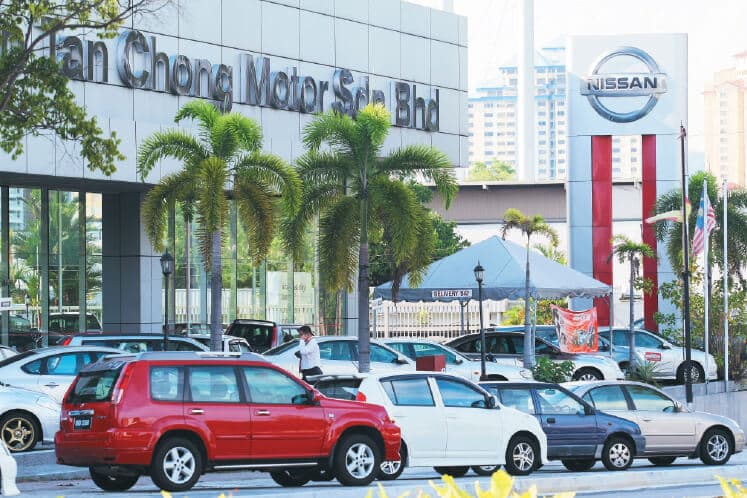
This article first appeared in The Edge Financial Daily on September 25, 2017
KUALA LUMPUR: The volume of motor vehicle sales last year dipped below 600,000 for the first time in six years, and this year's expected figure is likely to stay below that, according to the Malaysian Automotive Association (MAA).
The favourite lament of low consumer sentiment aside, the weaker ringgit has also proven to be a bane to auto retailers in the country, not least of which is Nissan vehicles distributor, Tan Chong Motor Holdings Bhd.
In an interview, Datuk Dr Ang Bon Beng, executive director at Edaran Tan Chong Motor Sdn Bhd — the sales and marketing arm of Tan Chong Motor for Nissan vehicles — said the most significant issue faced by auto players now is the depreciation of the ringgit, which “severely affects our bottom line”.
Hence, top of Tan Chong’s wish list for the upcoming Budget 2018, due to be tabled next month, is for the government to extend “special financial packages” to help automotive players stay profitable.
“As the auto sector is a key contributor to the country’s tax revenue, we seek the government’s support by providing special financial packages, for example, in the form of higher industrial linkage ratio, which is higher tax exemption for localisation, or reducing the excise duties,” Ang told The Edge Financial Daily.
Industrial linkage ratio is a rebate given for the localisation of content in the automotive industry. The current ratio is 1:1, said Ang, meaning the sum of tax exemption given corresponds directly to the cost of parts localised. Ang hopes the exemption given can be doubled.
However, the National Automotive Policy 2014 (NAP 2014) may get in the way of the goodies industry players are hoping for, as any changes to tax structures for the industry will mean reviewing the NAP. But Ang is keeping his fingers crossed. “Policies and incentives for the automotive industry are [usually] announced via the National Automotive Policy and not the budget. Nevertheless, any budget proposal which boosts consumer sentiment and improves Malaysians’ disposable income will support car sales," he said.
In Budget 2017, unveiled last October, two notable announcements related to the automotive sector were: i) those in the bottom 40% income group intending to participate in ride-sharing services like Grab and Uber could use their BR1M payout to settle the down payment for vehicles they buy for that purpose; and ii) they also get a RM4,000 rebate if they choose a Proton Iriz.
According to the American automotive website Jalopnik.com, Malaysia was the second most expensive country, right behind Singapore, to purchase and own a vehicle in 2013. Besides the 10% to 30% import duties on motor vehicles here, excise duties imposed start from 75% and can reach as high as 105%.
This tax structure, coupled with the weaker ringgit and lower consumer confidence amid slower economic growth, resulted in the total industry volume (TIV) in 2016 falling to 580,124 units, down 13% year-on-year (y-o-y) from the record-breaking 666,677 units recorded in 2015. Of course, 2015, which was the sixth straight year of annual sales growth, had the benefit of the pre-goods and services tax (GST) sales’ boost prior to April 1 that year, while post-GST, sales appeared to normalise, especially when year-end festive sales kicked in.
Meanwhile, total vehicle sales for August this year slid 0.96% y-o-y to 51,720 units versus 52,219 units previously. Notwithstanding that, year-to-date TIV was up 3.94% y-o-y to 384,730 units from 370,152 units, according to MAA.
For Bermaz Auto Bhd, the distributor of Mazda vehicles and spare parts in Malaysia, its concerns are centred on two themes: compliance with energy efficient vehicle (EEV) standards and exports.
“Our wish for Budget 2018 is for the government to push lower-priced cars to be EEV-compliant, instead of offering incentives to premium hybrid manufacturers, who don’t help the domestic automotive industry much without any large CKD (completely knocked down) volumes,” said Bermaz Auto executive director Datuk Francis Lee Kok Chuan.
EEVs are vehicles that meet a set of defined specifications in terms of carbon emission levels and fuel consumption, and include fuel-efficient vehicles, hybrids, electric vehicles and alternatively fuelled vehicles. Lee said all Mazda models, except for the BT50 pickup truck, are certified EEVs.
Meanwhile, CKD vehicles are those imported in parts and transported to an assembly plant in the target country, where all these parts are then assembled into complete units.
With the incentives provided under the NAP 2014, vehicles qualified as EEVs by the government get to enjoy tax exemptions between 10% and 40%, which can substantially lower their price tags. This was why premium automakers such as Mercedes-Benz Malaysia and BMW Group Malaysia have been able to sell their vehicles at slightly lower prices.
Lee further suggested that more incentives be provided for “those who genuinely export cars from Malaysia to support the industry and help transform the country into an automotive hub in the region”.
“The challenge for exporters like ourselves is to bring costs down, in order to be competitive for the export markets. The regional markets are very competitive with so much protectionism by various countries,” he said. Mazda Japan, as The Edge Financial Daily reported in April, is very bullish on Asean and wants to support Mazda Malaysia in making the country its exporting hub to the region. Mazda Malaysia is 30%-owned by Bermaz Auto.
However, automotive analysts said chances are the budget will contain minimal — if any — goodies for the automotive sector.
“There are usually minimal goodies for the automotive sector if we look at previous budgets. Of course, a bonus for industry players would be a reduction in the excise duties, [which] for consumers, [means] cheaper cars. But this means the NAP will have to be amended, which we don’t expect to happen for now,” UOB Kay Hian Securities (M) Sdn Bhd’s automotive analyst Fong Kah Yan said.